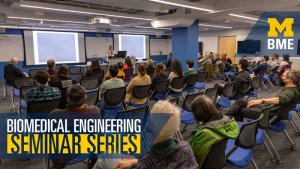Presented By: Biomedical Engineering
Biomedical Engineering Seminar Series
"Multi-Dimensional Optical Imaging: Novel Approaches and Biological Applications," with Oumeng Zhang, Ph.D.

Abstract:
Optical imaging is one of the most powerful imaging modalities due to its non-invasive nature, versatility, and ability to visualize phenomena across multiple scales. A key challenge in the field is capturing multi-dimensional data, such as polarization, phase, and fluorescence lifetime, with high precision and efficiency; these data provide a deeper understanding of various biomedical processes. This talk focuses on two recent advancements in optical imaging that address this critical challenge.
The first part focuses on single-molecule orientation localization microscopy. Fluorescent molecules behave as oscillating dipoles, with their dipole orientations affecting both absorption and emission processes. By leveraging the principles of light-matter interactions and advanced statistical tools, we have developed imaging systems capable of not only measuring the positions of individual fluorescent molecules with nanoscale resolution but also determining their orientations. This capability offers unparalleled insights into biophysical phenomena, such as membrane-protein interactions.
The second part covers advances in computational imaging, where optical systems are combined with computational tools, from closed-form mathematical relations to state-of-the-art neural network-based approaches, to enable unique multi-modal imaging and high-throughput data acquisition. Examples include a bimodal imaging system that integrates 3D fluorescence with quantitative phase imaging, and a single-shot volumetric fluorescence imaging system capable of capturing an entire 3D scene in a single snapshot.
These advancements demonstrate the integration of optical physics, engineering, and computational methods to enhance the capabilities of optical imaging for biomedical applications and biophotonics.
Zoom: https://umich.zoom.us/j/94337625486
Optical imaging is one of the most powerful imaging modalities due to its non-invasive nature, versatility, and ability to visualize phenomena across multiple scales. A key challenge in the field is capturing multi-dimensional data, such as polarization, phase, and fluorescence lifetime, with high precision and efficiency; these data provide a deeper understanding of various biomedical processes. This talk focuses on two recent advancements in optical imaging that address this critical challenge.
The first part focuses on single-molecule orientation localization microscopy. Fluorescent molecules behave as oscillating dipoles, with their dipole orientations affecting both absorption and emission processes. By leveraging the principles of light-matter interactions and advanced statistical tools, we have developed imaging systems capable of not only measuring the positions of individual fluorescent molecules with nanoscale resolution but also determining their orientations. This capability offers unparalleled insights into biophysical phenomena, such as membrane-protein interactions.
The second part covers advances in computational imaging, where optical systems are combined with computational tools, from closed-form mathematical relations to state-of-the-art neural network-based approaches, to enable unique multi-modal imaging and high-throughput data acquisition. Examples include a bimodal imaging system that integrates 3D fluorescence with quantitative phase imaging, and a single-shot volumetric fluorescence imaging system capable of capturing an entire 3D scene in a single snapshot.
These advancements demonstrate the integration of optical physics, engineering, and computational methods to enhance the capabilities of optical imaging for biomedical applications and biophotonics.
Zoom: https://umich.zoom.us/j/94337625486